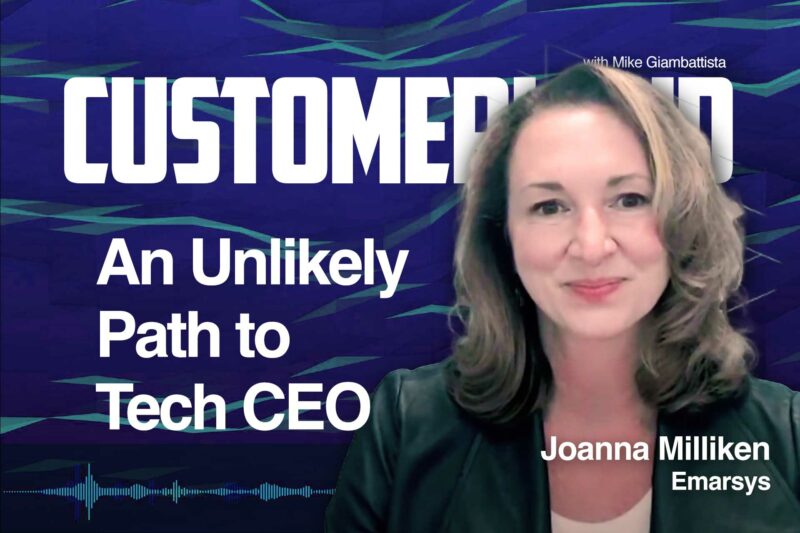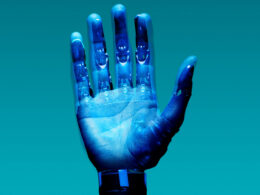Ever wondered what it takes to integrate two companies post-acquisition? Meet our guest, Emarsys‘ CEO Joanna Milliken, an experienced tech professional who has worked with giants like Hallmark, Exact Target, Salesforce, and SAP. She shares first-hand accounts about the formidable task of merging Emarsys with global behemoth, SAP. Discover the intricacies of uniting disparate systems, communicating the new power dynamics, and preserving employee morale amidst sweeping changes. We delve deep into the cultural tussles that emerge when a startup spirit meets corporate structure.
From the whirlwind of business transitions, we shift gears to the personal journey of our guest. As an English major who found herself in the seat of a CEO, the transition was far from smooth. Hear about the weight of leading teams across the globe and the constant need for context-switching. We discuss how individuals from non-business backgrounds can excel in executive roles. This episode is a treasure trove of insights, recounting a tale of corporate amalgamation and personal growth – tune in!
Download SAP Emarsys Customer Loyalty Index 2023 here.
Full transcript below
Joanna Milliken
There are absolutely moments where whether you call it imposter syndrome or whatever it is that it’s like how did I get here? How did an English major from Indiana University get here? So sometimes I reflect on that just from my own personal, like whoa, this isn’t quite what I expected. And then, yeah, the burden that you carry for people. You know, one of my first jobs was packing press kits at Hallmark, right Like we would pack a catalog and some samples and ship them out and make catalogs. I’ve worked in collateral, you know, so definitely been around since the dawn of digital. I helped make one of their first websites and I was lucky enough to get involved with a company called ExactTarget, which was a digital marketing platform, primarily email, back in those days. All of that that was later acquired by Salesforce and is now their marketing cloud product.
Throughout that journey, I had the opportunity to have just about every function in the company. So I’ve sold it, I’ve serviced it, I’ve implemented it, I’ve done tier one support, I’ve done it all, and I think that that’s really helped prepare me in ways that I didn’t even imagine. I never set out to be a CEO, sort of just like accidental. If I’m still like, how did I get here? But all of those experiences cumulatively now in my function, I think I just have a lot of understanding and empathy for what’s happening really throughout the organization. I know what it’s like to take calls during the day. I know what it’s like to try to work with customers and strategy. I know what it’s like to work with really big, global, complicated brands, and so I think that’s been really good In terms of kind of. When I came on board, I was definitely posed. The acquisition have been decided.
Mike Giambattista
All of that had Not, or it had been had right.
Joanna Milliken
So I basically decided before I came on board and I came on board at SAP. That was where I was, you know, recruited from and to work in general, I was told, on all the marketing products and think about how to evolve them and take them to the next level as part of the overall CX portfolio. A few weeks after joining was when we announced the acquisition of a Marsa. So I think I joined the end of August and we announced that like the beginning of November. So it was during that time that I was asked to take a probably informal GM role, if you will, to help manage that post-merger process, because it’s hard. It’s hard from a cultural level, first of all. You know, a company like a Emarsys, which is a much smaller scale, entering one of the largest software companies in the world is daunting and people don’t understand, don’t know what to expect, what that changes and so being and it’s not a given that that’ll work.
Mike Giambattista
I mean, there’s history that says it’s tough.
Joanna Milliken
Absolutely. It’s super hard. And then you know, like at a Emarsys some particular, they had an incredible founding team and organization. Those people had never really left and so the culture was really strong and the real feeling of a startup. And is that going to change? And all of those sorts of things are all super fair questions, right, because those do things. Those do change over time, the expectations of what your business needs to do, even from just like compliance type things. Right, it’s very different when you’re a part of a company like an SAP or another huge company, right, like that. So that was a part of it which is helping lead the organization right through that transformation, if you will.
Mike Giambattista
Can we talk a little bit about that and we don’t have to get too deep in the weeds about the messy stuff, but I think almost by definition it’s just as messy. I mean, you’re trying to match something you know apples to oranges often and it’s just really, really difficult. Can you talk a little bit about some of the specific hurdles you encountered and then?
Joanna Milliken
Yeah, let me think of some things that are kind of worthy of sharing, but I do think you’re right just in general. You know I’ve been at every stage. Right, I was the first employee at a company. I’ve been, I’ve gone public, I’ve been acquired, I’ve done acquisitions and you know, other than like really getting that seed round to get your idea off the ground, honest to God, I think the post-acquisition is the hardest, and that’s any company anywhere I’ve ever been involved with. It’s hard because primarily, like I said, the people coming first and I think the biggest challenges weren’t so much like systems integrations and those kinds of things which really are ongoing.
There’s that kind of things that are happening across the business which really impact the employees right at ground level, if you will, and what they do in their own employee experience. So making sure we didn’t lose the employee experience, right, it was definitely, I wouldn’t say like a challenge, but it is definitely front of mind, right For me, when we’re in this, especially when we’re in that first year post acquisition, like, are you onboarding at Emarsys? Are you onboarding at SAP? How do we explain that relationship? We’re like a company within a company. So all those kinds of questions that still to this day persist.
Mike Giambattista
Really.
Joanna Milliken
Quite honestly about like what does this mean? This is an ERP company, all that. So that really is kind of that ongoing answering of that and helping employees and other team members even around SAP understand that is just that education at scale. Right, we’re talking about a massive scale.
Mike Giambattista
I mean I’m thinking about some of the other conversations I’ve had with people who have had to manage, just you know, engineer those kinds of transitions, and so much of it ends up being, as you said a minute ago, it’s about the people and it’s also about their emotions. You know, people become especially for something, a company like Emarsys. I imagine people were kind of proprietary about what they had been doing there. I mean, you get that wonderful sense of ownership, but also you know that comes with a protective, as you were. Just you made the gesture, you know it’s a protective.
Joanna Milliken
A little bit of the Heisman we would say in the US right. Hold on, we’ve worked on this thing for 15 years and you just don’t know. And then the operating, like you said, particularly with engineering, but even go to market teams. It’s just different motions and so certainly I would say the cultural challenges were the hardest in a way with those product and engineering teams.
Because of that people love and own their products right, and that’s what we love about them. So sometimes getting them to, as we would say, like crack open the code and really let other people in is a tough trust thing. Right, that takes time.
Mike Giambattista
How did you do that? I mean, was that just a function of time, like it’s going to happen, so you might as well, or?
Joanna Milliken
Yes, yes, it was a kind of it’s a combination of things, right. It does just take time, right, and for me, it’s just like showing up saying the same thing over and over, showing that actually things are a lot better and that we can bring the best of both worlds together, and that’s such a unique opportunity and really getting people excited about what advantage this brings. Right, I think that’s the job you were asking earlier about, being a CEO, and I think one of the jobs as part of it that I’ve learned is I need to bring the energy into the organization, and so I think a big part of it was just simply, you know, the way that you’re going to be reminding people of what an advantage it is If we were still a standalone Emarsys company competing in the most competitive landscape in the world, especially during the macroeconomic conditions and the things that we’re seeing from marketers right now and all of that it’d be very hard for us to continue to grow and go upmarket and make it to the next level. And so SAP provides a clear advantage we’re able to interact with customers that we’ve always really been able to support Big brands, right. We’ve always had customers like Sheen and Reformation and Columbia and these brands, but now we’re being exposed to even more and it just gives us so much opportunity.
I think people get excited about it, sometimes daunted for sure, but overall excited With engineering. It was just a lot of show and tell. So one of the unique things I think about Emarsys that was like a mind shift change and certainly an evolution to that feeling of proprietary-ness, excuse me, was that engineering had originally all happened in a single location and so even just over the first, and we just did it gradually. There was even a lot of challenge about time zones and time zone management, right, which is fair, especially in very collaborative groups like that with user experience and the like. So, little by little right, helping them Emarsys turn into a really at scale global enterprise company is a gradual but large transformation. And so introducing some new concept, introducing them to teams in Waldorf, having them go back and forth, all those kinds of things, gradually mixing teams, if you will, those kinds of things, so a little more delicate, if you will, with the product and engineering organization.
Mike Giambattista
You kind of have to be.
Joanna Milliken
Yeah, it almost goes without saying, but I’m glad you said it, cause now it’s out there and everybody has to I know I get to travel with my teams, but it’s all like the good things you know.
Mike Giambattista
It is a good thing.
Joanna Milliken
We just wanted to make sure we didn’t break what was working.
Mike Giambattista
Right, right, but you really did have to, in a sense, kind of pull it apart and replace all those pieces so they could interact with each other on a global scale.
Joanna Milliken
Yeah, yeah.
Mike Giambattista
I mean just the thought process, forget about implementing it and what that must have been like. But you know how are we gonna globalize this thing that’s been so local for so long?
Joanna Milliken
Yeah, it’s the hardest thing I’ve ever done, I would say, in my career, and, of course, as they say, the most rewarding, but certainly the most challenging. Because, even if I didn’t physically break it apart right, we didn’t try to do things quite in that way Mentally I had to right and we had to reconstruct it and, with the leadership team, we had to get things through during the now but definitely have that North Star vision of how we want to work together and what the operating model has to be and how we advance, even things like how we organize our customer success teams around all these different segments and types of customers, when we used to be focused primarily on retail and CP or anything just direct to consumer. And now we have all these different kinds of business models that we supported, but they weren’t the majority.
Mike Giambattista
I’m just curious it’s a little bit off center here, but now that you’re part of a much bigger mothership servicing all these different kinds of clients, is your customer support systems had to evolve? Of course, but are you kind of just plugged into the larger SAP customer service customer success systems or does Emarsys still kind of operate on your own in terms of supporting your product?
Joanna Milliken
Yeah, well, it’s a little bit of both, so we definitely still maintain how we’ve always serviced our customers as a full staff model and not doing a very different kind of work than what SAP is doing. We’re not building robots on an assembly line, we’re doing marketing, so the support models are just generally different. So how we do that, though, is with we basically take the lead, so if there’s an SAP customer coming through, that’s a SAP wide, if you will, a larger part of the portfolio. It definitely starts with just general SAP support, and then we come in and add expertise, so we do get some advantages there from support, but it’s yeah, so, again, one of those advantages we work very closely with all the services teams. We partner in every region with all, like the regional presidents, you know, we work on the partner communities together, so there actually is a lot of alignment.
I’m again considering how kind of recently, in a way even though it seems like it’s been a long time it’s been about three years now in the scheme of things, and how these things go we’ve made a lot of traction in a pretty short time. I mean, we view it very much as like a like a channel park right, where we’re just internal marketing. Like here we are, we can help grow. We were easy to implement, easy to use. Customers get that, you know, return on value, or get that value right in time to market faster, while they’re maybe implementing Commerce Cloud right. So we have a. It’s a good joint value proposition, I think, for our customers and then also for SAP.
What Exactly is an Expectation Audit??
What could you achieve if you knew what your customers expected ahead of time? What if you could know what customers expect by category and by brand 12 to 18 months ahead of traditional brand tracking methods? And what if you could know exactly where to adjust and where to spend in order to derive the most benefit every time. A customer expectation audit allows you to identify areas that require strategic reinforcement, as well as pinpoint which values will contribute most to an emotional bond with your brand and optimize accordingly.
Customerland has partnered with Brand Keys, the world’s oldest loyalty focused consumer research firm, to bring real world customer expectation audits to brands, brand managers and to CX practitioners everywhere Want to know where your brand stands and exactly what to do about it.
Go to expectationaudit.com and download a sample audit today.
Mike Giambattista
Not to dwell on this, but I’m really just curious about it, is from what I could tell on your \LinkedIn profile, which is everything everybody could possibly know about a person. This is your first role and your first stint as a CEO. It is so, I thought, so Good. Thank you for confirming that transition. As you said you’ve done everything under the sun in this particular realm, but being the person at the pinnacle, the person who’s ultimately responsible for the whole thing, is entirely different. I’ve talked to a lot of CEOs and a lot of them have told me, when we get into this kind of a conversation, that transition personally was either the most natural thing they ever did, because they were just ready for it and here I am and boom, things just started clicking or it was most terrifying. You know what the heck have I done to myself and the people I’m now leading? And it doesn’t seem to be anything in the middle. It was either one or the other.
Joanna Milliken
I think it’s in the middle, because as an oldest child, someone who always was trying to be a backseat driver, I could backseat drive anything, but was always a leader, high energy, passionate, all that stuff. I do feel like I’m very suited. It just sort of does come naturally in terms of how I feel like I lead right Authentically and all that kind of thing. I do think that part of it comes very naturally. There are absolutely moments where whether you call it imposter syndrome or whatever it is that it’s like how did I get here? How did an English major from Indiana University get here? So sometimes I reflect on that just from my own personal, like whoa, this isn’t quite what I expected.
And then, yeah, the burden that you carry for people.
So, whether it’s the Russia-Ukraine war, right, I wasn’t expecting, when I came in to manage this business for some reason, these things of like oh, we have teams in Russia, I have a team in Tel Aviv, we have people in all these countries that are infected by cost of living and inflation or, you know, civil unrest and all these things happening in the world, and I talk to those people every day.
So that’s what I love about my job, is that every day I wake up and I’m talking to someone in a different hemisphere and it’s so fascinating and rewarding and I love bringing those teams together. And then there’s also a burden that you carry, or weight that you carry on behalf of what’s happening right to them, that you feel responsible. Whether you are or not, I do so. That’s kind of the heavy thing, and I think the other thing that actually wasn’t as prepared for even though I did all of these things is just that amount of context switching of going from a podcast recording to a 2024 financial planning right with 400 rows of an Excel spreadsheet, and those kinds of context switches are hard right. That’s hard, kind of throughout the day.
Mike Giambattista
So I’m really a little person. I’ve heard describe it as context switches, but I’ve this actually the hardest part of my life. I completely relate to it.
Joanna Milliken
Yeah.
Mike Giambattista
This is one thing I’m fully dialed in. I’m really enjoying this conversation. I’m going to have to switch in about a half hour to do something that’s completely different.
Joanna Milliken
Yeah, yeah, yeah. So let’s, let’s get into some other things you wanted to cover.
Mike Giambattista
So, yeah, yeah, let’s bring out the spreadsheets, let’s go have some fun here, not my, forte.
Joanna Milliken
Remember I said “English major”.
Mike Giambattista
Yeah, on that, I can’t tell you how many people I speak to who are senior level executives that came to it through deep liberal arts, deep like English majors, and I’m thinking I could have been an English major but I wasn’t smart enough and, you know, don’t know how to say half that stuff anyways, but actually all my English teachers kind of hated me. That was my thing, so I didn’t have a shot at it.
Joanna Milliken
I was very unhappy with my choice. Let’s just say that I mean, although I was like, but I think I’m going to go to law school, they’re like, what are you going to do with that? But I don’t know, maybe I shouldn’t say this I think these are public information. But like heads of product, like Parker Harris he was an English major A lot of like colleagues of mine that were at liberal arts schools or big universities even, but that were that are CEOs of startups.
It’s kind of funny, right, because it’s a little nuts, you only have a right brain or a left, whichever, yeah, right, you kind of have both.
Mike Giambattista
That’s funny. And on the other side of that, I was talking to somebody just last week who who’s a CEO, who came to it through the engineering kind of path and but again, like, admitted, like right up front he’s an engineer, he thinks through about life and business through an engineering lens and all of a sudden he was tasked with caring for people, which he was right. He said unprepared to do.
Joanna Milliken
I would say otherwise that’s why your leadership team is really what’s more important. So it is so true what they say right, Get the people so much smarter than you around the table and then just put them in the right positions and the rest just sort of naturally happens. You don’t actually, you know, you can just be hands off and watch them do their thing.
Mike Giambattista
Right.
Joanna Milliken
Got the right people in place.
Mike Giambattista
So this is a good moment to plug. I know a handful of people from the SAP world and I’m just so impressed with all of them your colleague Sarah Richter. I’ve spoken a handful of times. She’s a delight and super smart and there’s a within SAP proper guy named Nitin Badjatia.
Joanna Milliken
Uh-huh, yeah, yeah.
Mike Giambattista
And who’s one of the smartest guys I’ve ever met, period bar-none.
Joanna Milliken
Like I was saying, the people around me. So Sarah is the CMO for Emarsys, right? So I learn new things from her every day. Yeah, and Nitin is one of those people who he’s like a book. He just knows everything, about everything.
Mike Giambattista
It’s true, and he’s a nice enough guy.
Joanna Milliken
Yeah, I mean I find SAP really inspiring Like in the US, I think it’s like there is. We have a great video called “The Company that No One Heard Of”, and everything that happens in this whole world. Sap has touched it at some point and it’s pretty remarkable when you go to their lab and see the amount of innovation and things that they’re doing that you just don’t think about every day. It’s pretty remarkable to be aware of that.
Mike Giambattista
I’m going to try and shoehorn myself into one of those sessions at some point, but we’ll talk about that later.
Joanna Milliken
Yeah, yeah.
Mike Giambattista
I do want to talk about the latest version of the Loyalty Index. In fact that was, I think, the first time I got to speak to Sarah. The last year’s version had just been released, so we got to talk about some of the highlights there, some of the let’s just call it some of the changes, and I don’t know if you’re kind of top line familiar enough with it to talk it through.
Joanna Milliken
Yeah.
Mike Giambattista
But I kind of come from a loyalty background. To me, like pulling those things out is I can’t wait to share them.
Joanna Milliken
I wish I had there were water cooler still, because this is it’s pretty interesting, isn’t it, I mean it really is 10,000 consumers right All around the globe, and so it is interesting to see regional differences as well. Then it’s just some of the changes of consumer behavior. So it’s probably no surprise, but still a little daunting when you see it on paper, right, that loyalty just continues to decrease, and so we had seen, I think, a little uptick again.
Sarah could correct me there, but overall this year it’s been a drop and I think it goes hand in hand with and also what people reported again universally around the globe cost of living concerns, inflation concerns, and they don’t have a choice sometimes about being loyal when they have to be protecting their wallets.
So I think even something like we know this has been popular, especially with certain generations to make sure that the brand’s values align with your values, and we’re pretty steadfast on those right Typically, whether it’s environmental concerns or other things, and right now what we saw in this last report is price still will trump that. At the end of the day, people just have to make decisions that even might compromise right their values a little bit because of just what’s happening in their own lives, in their own context, and I think yeah. So I think those were some things that have changed. There’s some things that really stayed the same and, again along those lines, I think of things like incentive-based programs. Again, people still want that exchange. If I spend money with you and more money with you, or I promote you or I engage with you somehow, I want a very clear value exchange and I don’t think those kinds of programs will really ever go away. But it’s, how do you differentiate those?
Mike Giambattista
Right, right. It’s just interesting to me that everybody in the loyalty space – I’m painting a really broad brush and I’ll pay the price for this – but doesn’t like to talk publicly about the fact that loyalty, as we define it, is eroding kind of in a big, big way. Yeah, you know, it just is.
Joanna Milliken
We have to confront the brutal facts right. We can’t pretend like everyone loves us and they’re because we’ve got a cool brand or we’ve been doing our marketing right. That means we’ve created loyalty right. Loyalty is an outcome. It’s not a software, it’s not a points program. In my mind, right, it’s the what every marketers dream is, and so I do think that it’s a balance of really talking about that broadly but thinking about it like how do you get that short-term and maximize those short-term opportunities that you’ve got to be thinking right, the long tail, or you’re just not going to win right now.
Mike Giambattista
Right, it correlates pretty interestingly with some other research we were just looking at. This company measures customer expectations by category and then by brand within the category, and the way they do it is which is an exact correlation to what you’re saying is they measure the ultimate, what customers expect in a category. Ultimately, what would be the ideal Like if you’re going to go shop for a car, what are your expectations If everything just went beautifully, what would that look like? And then how do certain car brands, in this case, measure up there? And what their data has shown is that customer expectations rise certain in some categories really quickly and outpace company’s ability to keep up with that. So there’s this growing gap.
Joanna Milliken
So often It’d be interesting to see that, like you said, compared to other industries, because I think, as you and I would especially know, whatever your last great experience was whether that was checking into your hotel or talking to the person who’s in an elevator whatever your last great experience was is now your expectation for the next.
Mike Giambattista
Right.
Joanna Milliken
So we also just keep perpetuating the need of increasing those expectations, and all of that in a way too.
Mike Giambattista
Yeah, I mean. That’s why a lot of these folks were super annoyed with Amazon, because those expectations they cross categories too Right, if I can get free shipping from Amazon, why can’t I get it over here from you guys or whatever happens to me?
Joanna Milliken
And so then we all kind of race to the bottom, I think in some regard, unfortunately.
Mike Giambattista
I’ll put two cookies on the pillow. See that? That’s how that works.
Joanna Milliken
Well, we’ve seen a lot of our customers doing a lot of things very well A lot of new approaches to generational marketing, I would say, in terms of really making sure that they’re fully omnichannel, so that they’re reaching all different types of customers, particularly in things like beauty or even automotive right, when there’s loyalty to a brand and it can be multi-generational. So things like that have been pretty interesting that our customers are doing. I’ll see you guys next time.














